 The latest UK house price index reveals that annual house price growth in the UK slowed to just 1.2 per cent in May. This is the lowest rate of growth since January 2013. This is being driven, in part, by the London market where annual house price inflation rates have now been negative for 15 consecutive months. In May the annual rate of house price inflation in London fell to -4.4 per cent, it lowest since August 2009 as the financial crisis was unfolding. However, closer inspection of the figures show that while many other parts of the country continue to experience positive rates of annual house price inflation, once general inflation is accounted for, there is widespread evidence of widespread real house price deflation.
The latest UK house price index reveals that annual house price growth in the UK slowed to just 1.2 per cent in May. This is the lowest rate of growth since January 2013. This is being driven, in part, by the London market where annual house price inflation rates have now been negative for 15 consecutive months. In May the annual rate of house price inflation in London fell to -4.4 per cent, it lowest since August 2009 as the financial crisis was unfolding. However, closer inspection of the figures show that while many other parts of the country continue to experience positive rates of annual house price inflation, once general inflation is accounted for, there is widespread evidence of widespread real house price deflation.
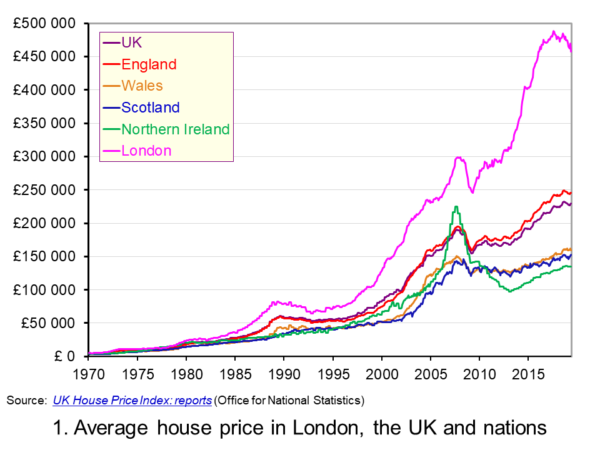 The average UK house price in May 2019 was £229,000. As Chart 1 shows, this masks considerable differences across the UK. In England the average price was £246,000 (an annual increase of 1.0 per cent), in Scotland it was £153,000 (an increase of 2.8 per cent), in Wales £159,000 (an increase of 3.0 per cent) and in Northern Ireland it was £137,000 (an increase of 2.1 per cent). (Click here to download a PowerPoint copy of the chart.)
The average UK house price in May 2019 was £229,000. As Chart 1 shows, this masks considerable differences across the UK. In England the average price was £246,000 (an annual increase of 1.0 per cent), in Scotland it was £153,000 (an increase of 2.8 per cent), in Wales £159,000 (an increase of 3.0 per cent) and in Northern Ireland it was £137,000 (an increase of 2.1 per cent). (Click here to download a PowerPoint copy of the chart.)
The London market distorts considerably the English house price figures. In London the average house price in May 2019 was £457,000 (an annual decrease of 4.4 per cent). House prices were lowest in the North East region of England at £128,000. The North East was the only other English region alongside London to witness a negative rate of annual house price inflation, with house prices falling in the year to May 2019 by 0.7 per cent.
 Chart 2 allows us to see more readily the rates of house price growth. It plots the annual rates of house price inflation across London, the UK and its nations. What is readily apparent is the volatility of house price growth. This is evidence of frequent imbalances between the flows of property on to the market to sell (instructions to sell) and the number of people looking to buy (instructions to buy). An increase in instructions to buy relative to those to sell puts upwards pressure on prices whereas an increase in the relative number of instructions to sell puts downward pressure on prices. (Click here to download a PowerPoint copy of the chart.)
Chart 2 allows us to see more readily the rates of house price growth. It plots the annual rates of house price inflation across London, the UK and its nations. What is readily apparent is the volatility of house price growth. This is evidence of frequent imbalances between the flows of property on to the market to sell (instructions to sell) and the number of people looking to buy (instructions to buy). An increase in instructions to buy relative to those to sell puts upwards pressure on prices whereas an increase in the relative number of instructions to sell puts downward pressure on prices. (Click here to download a PowerPoint copy of the chart.)
Despite the volatility in house prices, the longer-term trend in house prices is positive. The average annual rate of growth in house prices between January 1970 and May 2019 in the UK is 9.1 per cent. For England the figure is 9.4 per cent, for Wales 8.8 per cent, for Scotland 8.5 per cent and for Northern Ireland 8.3 per cent. In London the average rate of growth is 10.4 per cent per annum.
 As Chart 3 illustrates, the longer-term growth in actual house prices cannot be fully explained by the growth in consumer prices. It shows house price values as if consumer prices, as measured by the Retail Prices Index (RPI), were fixed at their January 1987 levels. We see real increases in house prices or, expressed differently, in house prices relative to consumer prices. In real terms, UK house prices were 3.6 times higher in May 2019 compared to January 1970. For England the figure is 4.1 times, for Wales 3.1 times, for Scotland 2.9 times and for Northern Ireland 2.1 times. In London inflation-adjusted house prices were 5.7 times higher. (Click here to download a PowerPoint copy of the chart.)
As Chart 3 illustrates, the longer-term growth in actual house prices cannot be fully explained by the growth in consumer prices. It shows house price values as if consumer prices, as measured by the Retail Prices Index (RPI), were fixed at their January 1987 levels. We see real increases in house prices or, expressed differently, in house prices relative to consumer prices. In real terms, UK house prices were 3.6 times higher in May 2019 compared to January 1970. For England the figure is 4.1 times, for Wales 3.1 times, for Scotland 2.9 times and for Northern Ireland 2.1 times. In London inflation-adjusted house prices were 5.7 times higher. (Click here to download a PowerPoint copy of the chart.)
The volatility in house prices continues to be evident when adjusted for changes in consumer prices. The UK’s annual rate of real house price inflation was as high as 40 per in January 1973, yet, on the other hand, in June 1975 inflation-adjusted house prices were 16 per cent lower than a year earlier. Over the period from January 1970 to May 2019, the average annual rate of real house price inflation was 3.2 per cent. Hence house prices have, on average, grown at an annual rate of consumer price inflation plus 3.2 per cent.
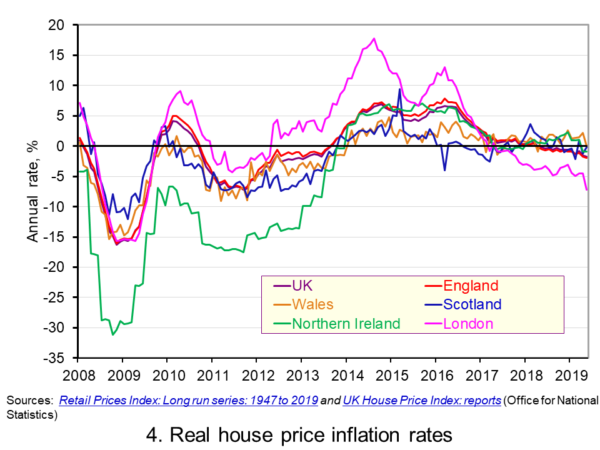 Chart 4 shows annual rates of real house price inflation since 2008 and, hence, from around the time the financial crisis began to unfold. The period is characterised by acute volatility and with real house prices across the UK falling at an annual rate of 16 per cent in 2009 and by as much 29 per cent in Northern Ireland. (Click here to download a PowerPoint copy of the chart.)
Chart 4 shows annual rates of real house price inflation since 2008 and, hence, from around the time the financial crisis began to unfold. The period is characterised by acute volatility and with real house prices across the UK falling at an annual rate of 16 per cent in 2009 and by as much 29 per cent in Northern Ireland. (Click here to download a PowerPoint copy of the chart.)
The UK saw a rebound in nominal and real house price growth in the period from 2013, driven by a strong surge in prices in London and the South East, and supported by government initiatives such as Help to Buy designed to help people afford to buy property. But house price growth then began to ease from early/mid 2016. Some of the easing may be partly due to any excessive fizz ebbing from the market, especially in London, and the impact on the demand for buy-to-let investments resulting from reductions in tax relief on interest payments on buy-to-let mortgages.
However, the housing market is notoriously sensitive to uncertainty, which is not surprising when you think of the size of the investment people are making when they enter the market. The uncertainty surrounding Brexit and the UK’s future trading relationships will have been a drag on demand and hence on house prices.
Chart 4 shows that by May 2019 all the UK nations were experiencing negative rates of real house price inflation, despite still experiencing positive rates of nominal house price inflation. In Wales the real annual house price inflation rate was -0.1 per cent, in Scotland -0.2 per cent, in Northern Ireland -0.9 per cent and in England -2.0 per cent. Meanwhile in London, where annual house price deflation has been evident for 15 consecutive months, real house prices in May 2019 were falling at an annual rate of 7.2 per cent.
Going forward the OBR’s Fiscal Risks Report predicts that, in the event of a no-deal, no-transition exit of the UK from the European Union, nominal UK house prices would fall by almost 10 per cent between the start of 2019 and mid-2021. This forecast is driven by the assumption that the UK would enter a year-long recession from the final quarter of 2019. It argues that property transactions and prices ‘move disproportionately’ during recessions. (See John’s blog The costs of a no-deal Brexit for a fuller discussion of the economics of a no-deal Brexit). The danger therefore is that the housing market becomes characterised by both nominal and real house price falls.
Articles
Questions
- Explain the difference between a rise in the rate of house price inflation a rise in the level of house prices.
- Explain the difference between nominal and real house prices.
- If nominal house prices rise can real house price fall? Explain your answer.
- What do you understand by the terms instructions to buy and instructions to sell?
- What factors are likely to affect the levels of instructions to buy and instructions to sell?
- How does the balance between instructions to buy and instructions to sell affect house prices?
- How can we differentiate between different housing markets? Illustrate your answer with examples.
 House prices in the UK are rising and the rise seems to be accelerating – at least until the latest month (August). They are now growing at an annualised rate of nearly 4%. This is the fastest rate for three years (see chart below: click here for a PowerPoint of the chart).
House prices in the UK are rising and the rise seems to be accelerating – at least until the latest month (August). They are now growing at an annualised rate of nearly 4%. This is the fastest rate for three years (see chart below: click here for a PowerPoint of the chart).
This may be worrying for Mark Carney, the Governor of the Bank of England, who is committed to avoiding a new house price bubble. 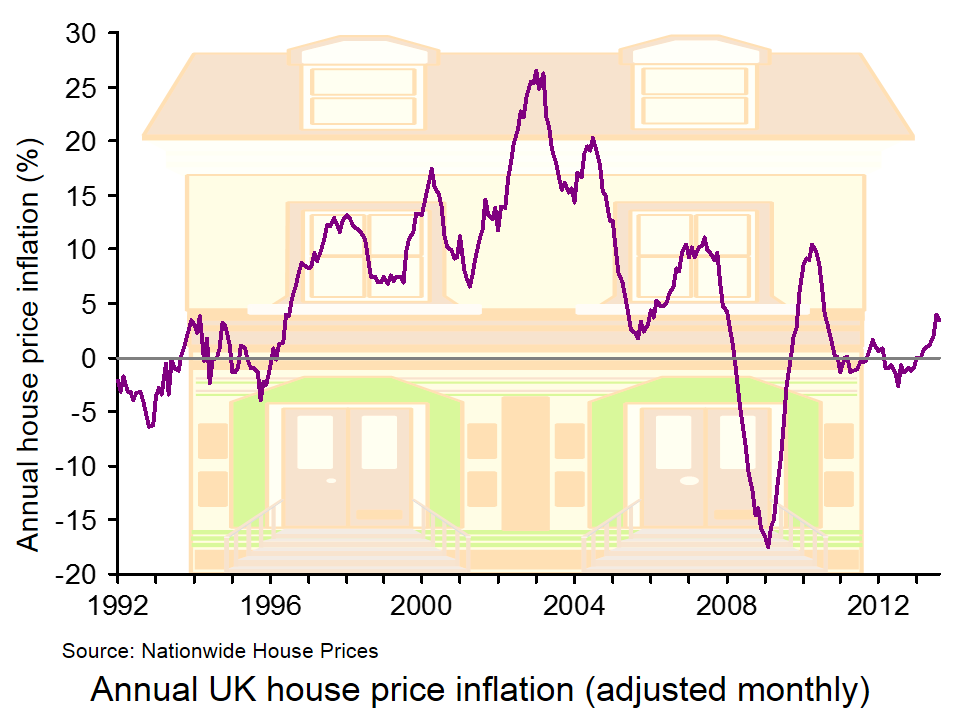 The problem is that, under the recently issued forward guidance, the Bank of England is set to retain the current historically low Bank rate of 0.5% until unemployment has fallen to 7%. But that could be some time – probably around two years.
The problem is that, under the recently issued forward guidance, the Bank of England is set to retain the current historically low Bank rate of 0.5% until unemployment has fallen to 7%. But that could be some time – probably around two years.
So what can the Bank do in the meantime and what will be the consequences?
The following article from The Guardian looks at the options.
Article
How can the Bank of England prick the house price bubble? The Guardian, Patrick Collinson and Heather Stewart (30/8/13)
Data
Links to house price data The Economics Network, John Sloman
Questions
- What constitutes a housing price boom? Is the UK currently experiencing such a boom?
- What factors have led to the recent house price rises? Have these factors affected the demand or supply of houses (or both)?
- Who gains and who loses from rising house prices?
- Explain the policy adopted in New Zealand to curb house price inflation.
- Consider the merits of this option?
- Could borrowers find ways around this measure?
- Are there any other options open to the Bank of England?
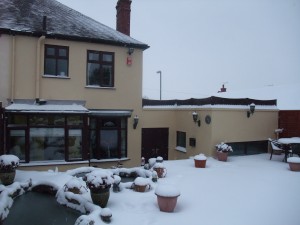 The housing market is an incredibly fascinating market to monitor and to research. The market was at the centre of the financial crisis with some lenders accused of over-aggressively expanding their mortgage books and relaxing their lending criteria. The UK housing market of today looks very different to the market before the financial crisis. Nationally, house prices are stagnant while transaction numbers are less than half their pre-crisis level. The UK housing market appears almost as ‘cold’ as the recent weather!
The housing market is an incredibly fascinating market to monitor and to research. The market was at the centre of the financial crisis with some lenders accused of over-aggressively expanding their mortgage books and relaxing their lending criteria. The UK housing market of today looks very different to the market before the financial crisis. Nationally, house prices are stagnant while transaction numbers are less than half their pre-crisis level. The UK housing market appears almost as ‘cold’ as the recent weather!
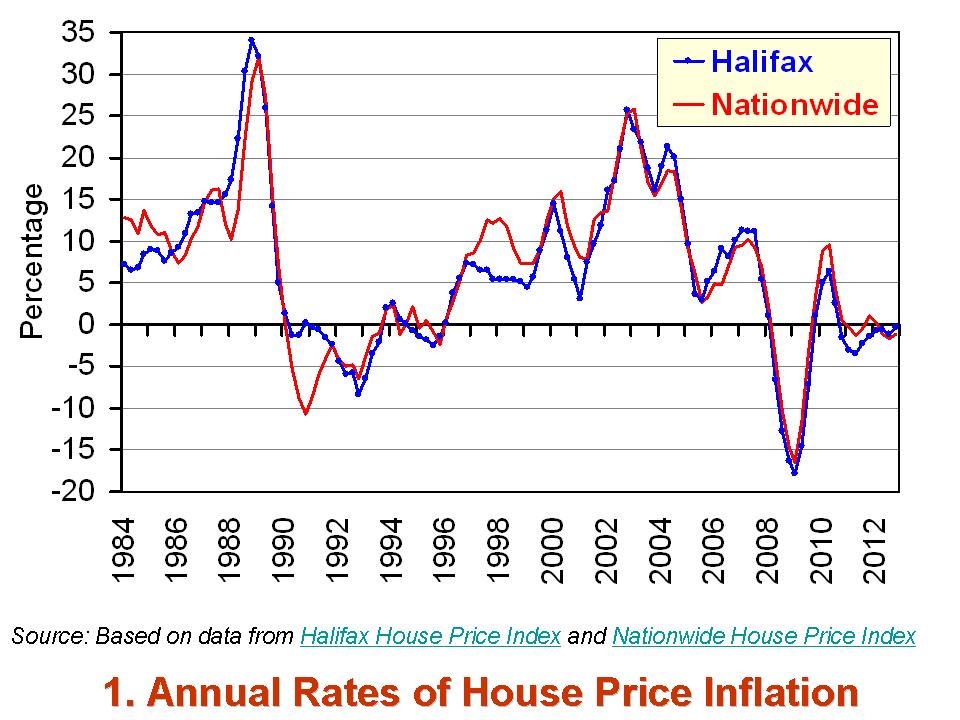
As the first chart shows, the annual rate of house price inflation across the UK has been consistently close to or even below zero over the past couple of years. The latest figures from the Nationwide Building Society point to the average UK house price in the final quarter of 2012 being 1.1 per cent lower than in the final quarter of 2011. The figures from the Halifax concur with their estimate showing UK house prices 0.3 per cent lower year-on-year in the final quarter of 2012. This is a very different picture from that during the 2000s. As recently as 2007, the annual rate of house price inflation was in excess of 10 per cent.
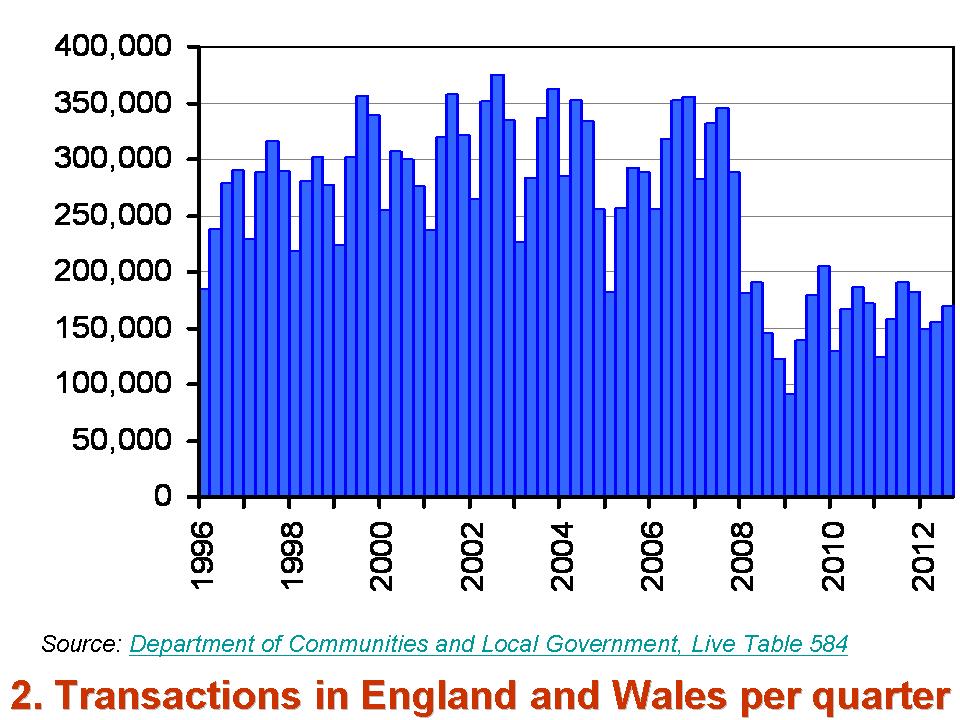 Another indicator of the changing face of the UK housing market is the level of activity. The second chart shows the number of transactions per quarter across England and Wales since 1996. The figures from the Department of Communities and Local Government show that since the start of 2010 England and Wales has seen an average of 159,000 transactions per quarter. This compares with an average of 294,000 transactions over the period from 1996 to the end of 2007. Hence, the number of purchases today is roughly half the level prior to the financial crisis.
Another indicator of the changing face of the UK housing market is the level of activity. The second chart shows the number of transactions per quarter across England and Wales since 1996. The figures from the Department of Communities and Local Government show that since the start of 2010 England and Wales has seen an average of 159,000 transactions per quarter. This compares with an average of 294,000 transactions over the period from 1996 to the end of 2007. Hence, the number of purchases today is roughly half the level prior to the financial crisis.
 A further indicator of today’s very different housing market is the numbers of approvals by lenders for mortgages for house purchases. The latest Bank of England figures show that across the UK, the number of approvals each month in the first eleven months of 2012 averaged 51,000. Since 2010, the average monthly number of approvals has been 49,000. However, over the period from 1996 to the end of 2007 there were over 102,000 mortgages being approved each month.
A further indicator of today’s very different housing market is the numbers of approvals by lenders for mortgages for house purchases. The latest Bank of England figures show that across the UK, the number of approvals each month in the first eleven months of 2012 averaged 51,000. Since 2010, the average monthly number of approvals has been 49,000. However, over the period from 1996 to the end of 2007 there were over 102,000 mortgages being approved each month.
A trawl through some of the key indicators of the UK housing market helps to paint a picture of a market that is markedly different to that before the financial crisis. It would be a big surprise in today’s financial and economic climate if there were to be any significant change in the path of these indicators for some time.
Data
Statistical data set – Property transactions Department of Communities and Local Government
Nationwide house price index Nationwide Building Society
Halifax House Price Index Lloyds Banking Group
Lending to individuals – November 2012 Bank of England
Articles
UK house prices drop 1% Guardian, Hilary Osborne (3/1/13)
House prices on course to pass pre-crisis peak levels Telegraph, Roland Gribben (21/1/13)
House prices rise at highest rate in seven months Independent, Vicky Shaw (15/1/13)
UK mortgage market ‘now more robust’ BBC News, (21/1/13)
Bank of England report flags improving mortgage market Telegraph, Emma Rowley (21/1/13)
Questions
- Draw up a list factors that are likely to have affected each of our 3 indicators of the UK housing market (house price inflation, transactions and mortgage approvals) since the late 2000s.
- Using a demand-supply diagram, illustrate the forces that have affected house prices in the late 2000s and early 2010s.
- Draw up a list of issues surrounding the housing market that would be of interest to a microeconomist. Now repeat the exercise for a macroeconomist.
- Why are house prices so notoriously volatile? Can you think of any other markets where prices are similarly volatile? Do these markets share any common traits?
- If you were a commentator on the UK housing market what would you be forecasting for prices and activity in 2013?
This week has seen the publications of two sets of forecasts on the UK housing market in 2011. The first of these came from Rightmove. It is forecasting that house prices next year could fall by as much as 5%. The extent of the fall though is argued to dependent, in part, on any rise in the Bank of England’s base rate and the number of properties taken into possession by lenders. These two factors are, of course, linked because higher debt-servicing costs can contribute to repossessions as the affordability of mortgages decrease. An increase in what are termed ‘forced sales’ will add to Rightmove’s general expectation of over-supply of property.
Righmove are expecting considerable local variations in house prices as a result of local demand and supply conditions. This makes forecasting a national average house price change extraordinarily difficult. It argues that the extent to which potential buyers are credit-constrained or to which demand is ‘credit crunch resistant’ varies across the country. This coupled with variations in the amount of supply to local markets will contribute to considerable differences in house price movements with house prices being ‘underpinned’ in some markets.
Rightmove is expecting the number of properties coming on to the housing market in 2011 to be around 1.2 million, 10% lower than in 2010. However, it is expecting only around 600,000 transactions which is close to half the historic average.
The second set of housing market forecasts this week was published by the Council of Mortgage Lenders (CML). The CML is forecasting that low interest rates will help to underpin current house price values with ‘flat or modestly falling house prices’. They argue that that while recent house price weakness will persist they ‘do not foresee any sharp fall in prices’. The CML are not expecting large numbers of buyers to hold off from looking to buy, but acknowledge there is uncertainty about the availability and cost of mortgage funding.
One contributing factor to the uncertainty surrounding the quantity and price of mortgages is the end to the Bank of England’s Special Liquidity Scheme (SLS). The SLS allowed banks to swap for a period of up to 3 years financial assets, such as mortgage-backed securities (a security representing a claim on the cash flows from mortgage loans), for UK Treasury Bills (short-term government debt). The scheme was designed to provide the banking system with liquidity. The last swaps will expire in January 2012. The CML reports that currently about £130 billion needs to be repaid by banks. More generally, of course, financial institutions are likely in 2011 to continue repairing and rebalancing their balance sheets and this is likely to impact on their lending decisions.
We noted how the Rightmove house price forecast for 2011 was partly dependent on those forced sales arising from repossessions. The CML is expecting what it terms a ‘modest increase’ in the number of possessions from around 36,000 this year to 40,000 next year. The CML though expects the number of transactions in 2011 to be a little higher than Rightmove, albeit still historically low at around 860,000.
All in all, activity levels in the housing and mortgage markets in 2011 are expected to be relatively subdued. This coupled with the expectation that house prices will be lower in 2011 suggests a very sober outlook indeed for the UK housing market. Happy New Year!
Articles
Lenders forecast flat house prices Financial Times, Norma Cohen (14/12/10)
UK mortgage lending to fall to 30-year low Telegraph, Steven Swinford (15/12/10)
Repossessions to rise in 2011, lenders forecast BBC News (15/12/10)
Market freeze: Homes sold once in 20 years Sky News, Hazel Baker (15/12/10)
U.K. mortgage lending may decline by a third in 2011 as weakness persists Bloomberg, Scott Hamilton (15/12/10)
House prices fall faster as estate agent predicts worse to come Telegraph, Ian Cowie (13/12/10)
Home sellers warned to drop asking price by 5% if they want to find a buyer Daily Mail, Becky Barrow (13/12/10)
U.K. home sellers may cut prices by as much as 5% in 2011 after December drop Bloomberg, Scott Hamilton (13/12/10)
Housing market forecasts
Rightmove’s housing market forecasts can be found within the December 2010 edition of its House Price Index
Rightmove December 2010 House Price Index (13/12/10)
CML publishes 2011 market forecasts CML News and Views, Issue 24 (15/12/10)
Questions
- Compare and contrast the Rightmove and CML house price forecasts for 2011. How similar are the stories underpinning their forecasts?
- What do you understand by forced sales? Using a demand-supply diagram explore how an increase in properties taken into possession could impact on house prices in 2011.
- What do you think affordability means in the context of housing? How might we measure this?
- What factors do you think might impact on the price and availability of mortgage finance in 2011?
- What do you understand to be the purpose of the Bank of England’s Special Liquidity Scheme. Using a demand-supply diagram explore how the termination of the scheme early in 2012 could impact on house prices in 2011.
- What do you think Rightmove means by ‘credit crunch resistant’ housing demand?
- Can demand-supply analysis help to explain how house prices pressure could vary from one area to another? Explain your answer using appropriate diagrams.
House prices are in the news again, but that should come as no surprise because they are such a favourite topic of the British! Three different organisations – the Halifax Bank, the Nationwide Building Society and Rightmove – have all reported that house prices fell in November. The Halifax reported a 0.1% fall, the Nationwide a 0.3% fall and Rightmove a 3.2% fall. The Halifax and Nationwide base their figures on house price information supplied by prospective mortgage applicants while Rightmove report the average asking price of those putting their property on to the market. We should not worry too much about the variations in the magnitude of the reported price falls because the downward trend in house prices is now pretty well established. The Halifax, for instance, has reported five monthly falls since April and they estimate that the average house price over the three months to November is 0.7% lower than a year ago. While the other two organisations are still reporting annual house price inflation rates in positive territory, these rates too are edging closer and closer to negative territory.
The recent falls in house prices come after a rebound in prices in the second half of 2009 which carried on into the early months of this year. The Nationwide had annual house price inflation rates peaking in the spring at around the 10% mark. This appears to have reflected an increase in housing demand and can be seen in the Bank of England mortgage approval numbers for house purchase which recovered from as low as 26,702 in November 2008 to 59,215 in November 2009. By April, Rightmove was reporting that property supply was beginning to outstrip demand and in their May report they noted that suppliers were coming on to the market more quickly than at any time since June 2008. It is argued that supply increased further through late May and into June when the new coalition government suspended house information packs (HIPs). HIPs were a set of documents, including a property information questionnaire, which a seller needed to provide before a property could be marketed.
Rightmove reported in their November press release that the number of new sellers coming to the market each week between 10 October and 6 November averaged 24,028. This was a fall of 9.1% on the previous 4-week period. But, we need to see this reduction in the context of housing demand and the mortgage approvals numbers again provide clues as to the strength of housing demand. The fall in approvals in October to just 47,185 approvals was the sixth consecutive monthly fall. This number of approvals, as Rightmove note, is about half the monthly number of additional properties coming on to the market. In other words, the flow of properties coming on to the market is contributing to a large stock of properties on the books of estate agents. While some existing suppliers have been taking their property off the market, Rightmove note that the current average number of unsold properties on estate agents’ books is only a little down on the historic high reported a couple of months back. This leaves sellers fighting over a limited number of prospective buyers.
In the short term, the extent of further downward pressure on house prices will depend on extent of the imbalance between demand and supply. If a large number of suppliers begin to remove their property from the market, perhaps on the hope that the market will improve later next year, this would help to address the imbalance. Equally, if first-time buyers were to return to the market in larger numbers then that too would help to alleviate downward pressure on prices. The latter, however, is unlikely given the tight credit conditions which are resulting in potential first-time buyers struggling to find the deposit needed to get on to the property ladder. It seems that while many wannabe buyers of property may have a willingness to purchase, their ability to purchase continues to be frustrated by their inability to find the necessary deposit.
Articles
House prices slip further in November Financial Times, Norma Cohen (9/12/10)
Bonus for first-time buyers as house prices plummet for the third month in a row Daily Mail (9/12/10)
House prices drop fort he third month, has the bubble burst? London Daily News (9/12/10)
House prices fall 0.1% but hopes rise Independent, Peter Cripps (9/12/10)
House prices drop amid mortgage ‘deep freeze’ Telegraph, Myra Butterworth (9/12/10)
Data
Mortgage approval numbers are available from the Bank of England’s statistics publication, Monetary and Financial Statistics (Bankstats) (See Table A5.4.)
Halifax House Price Index Halifax (part of the Lloyds Banking Group)
Nationwide House Price Index Nationwide Building Society
Rightmove House Price Index Rightmove
Live Tables on Housing Market and House Prices Department of Communities and Local Government
Questions
- Tracking house prices is like following a roller-coaster ride! See if you can re-tell the story of UK house prices over the past year using demand and supply diagrams.
- Why do you think UK house prices are so volatile? Can you point to any other market where prices are so volatile? If so, do they share any common features?
- How important are first-time buyers in affecting house prices? What factors do you think affect the number of prospective first-time buyers deciding to enter the housing market?
- Using a demand and supply diagram illustrate the effect on house prices of: (i) a tightening of financial institutions’ lending criteria; (ii) the expectation of forthcoming house price falls; and (iii) increasing economic confidence .
- Although UK house prices are volatile they do increase over the longer-term and by more than the average price of consumer goods and services. What might explain this?
- What do we mean by a demand-supply imbalance? Would you expect this imbalance to continue?
- The average house price is currently falling. But, different housing markets will have their own price patterns. What might explain any differences in house price patterns across different housing markets?
 The latest UK house price index reveals that annual house price growth in the UK slowed to just 1.2 per cent in May. This is the lowest rate of growth since January 2013. This is being driven, in part, by the London market where annual house price inflation rates have now been negative for 15 consecutive months. In May the annual rate of house price inflation in London fell to -4.4 per cent, it lowest since August 2009 as the financial crisis was unfolding. However, closer inspection of the figures show that while many other parts of the country continue to experience positive rates of annual house price inflation, once general inflation is accounted for, there is widespread evidence of widespread real house price deflation.
The latest UK house price index reveals that annual house price growth in the UK slowed to just 1.2 per cent in May. This is the lowest rate of growth since January 2013. This is being driven, in part, by the London market where annual house price inflation rates have now been negative for 15 consecutive months. In May the annual rate of house price inflation in London fell to -4.4 per cent, it lowest since August 2009 as the financial crisis was unfolding. However, closer inspection of the figures show that while many other parts of the country continue to experience positive rates of annual house price inflation, once general inflation is accounted for, there is widespread evidence of widespread real house price deflation. The average UK house price in May 2019 was £229,000. As Chart 1 shows, this masks considerable differences across the UK. In England the average price was £246,000 (an annual increase of 1.0 per cent), in Scotland it was £153,000 (an increase of 2.8 per cent), in Wales £159,000 (an increase of 3.0 per cent) and in Northern Ireland it was £137,000 (an increase of 2.1 per cent). (Click here to download a PowerPoint copy of the chart.)
The average UK house price in May 2019 was £229,000. As Chart 1 shows, this masks considerable differences across the UK. In England the average price was £246,000 (an annual increase of 1.0 per cent), in Scotland it was £153,000 (an increase of 2.8 per cent), in Wales £159,000 (an increase of 3.0 per cent) and in Northern Ireland it was £137,000 (an increase of 2.1 per cent). (Click here to download a PowerPoint copy of the chart.) Chart 2 allows us to see more readily the rates of house price growth. It plots the annual rates of house price inflation across London, the UK and its nations. What is readily apparent is the volatility of house price growth. This is evidence of frequent imbalances between the flows of property on to the market to sell (instructions to sell) and the number of people looking to buy (instructions to buy). An increase in instructions to buy relative to those to sell puts upwards pressure on prices whereas an increase in the relative number of instructions to sell puts downward pressure on prices. (Click here to download a PowerPoint copy of the chart.)
Chart 2 allows us to see more readily the rates of house price growth. It plots the annual rates of house price inflation across London, the UK and its nations. What is readily apparent is the volatility of house price growth. This is evidence of frequent imbalances between the flows of property on to the market to sell (instructions to sell) and the number of people looking to buy (instructions to buy). An increase in instructions to buy relative to those to sell puts upwards pressure on prices whereas an increase in the relative number of instructions to sell puts downward pressure on prices. (Click here to download a PowerPoint copy of the chart.) As Chart 3 illustrates, the longer-term growth in actual house prices cannot be fully explained by the growth in consumer prices. It shows house price values as if consumer prices, as measured by the Retail Prices Index (RPI), were fixed at their January 1987 levels. We see real increases in house prices or, expressed differently, in house prices relative to consumer prices. In real terms, UK house prices were 3.6 times higher in May 2019 compared to January 1970. For England the figure is 4.1 times, for Wales 3.1 times, for Scotland 2.9 times and for Northern Ireland 2.1 times. In London inflation-adjusted house prices were 5.7 times higher. (Click here to download a PowerPoint copy of the chart.)
As Chart 3 illustrates, the longer-term growth in actual house prices cannot be fully explained by the growth in consumer prices. It shows house price values as if consumer prices, as measured by the Retail Prices Index (RPI), were fixed at their January 1987 levels. We see real increases in house prices or, expressed differently, in house prices relative to consumer prices. In real terms, UK house prices were 3.6 times higher in May 2019 compared to January 1970. For England the figure is 4.1 times, for Wales 3.1 times, for Scotland 2.9 times and for Northern Ireland 2.1 times. In London inflation-adjusted house prices were 5.7 times higher. (Click here to download a PowerPoint copy of the chart.) Chart 4 shows annual rates of real house price inflation since 2008 and, hence, from around the time the financial crisis began to unfold. The period is characterised by acute volatility and with real house prices across the UK falling at an annual rate of 16 per cent in 2009 and by as much 29 per cent in Northern Ireland. (Click here to download a PowerPoint copy of the chart.)
Chart 4 shows annual rates of real house price inflation since 2008 and, hence, from around the time the financial crisis began to unfold. The period is characterised by acute volatility and with real house prices across the UK falling at an annual rate of 16 per cent in 2009 and by as much 29 per cent in Northern Ireland. (Click here to download a PowerPoint copy of the chart.)




